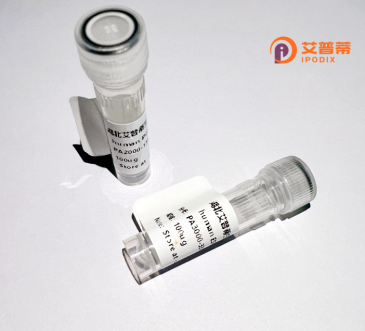
| 纯度 | >90%SDS-PAGE. |
| 种属 | Human |
| 靶点 | EIF3EIP |
| Uniprot No | Q9Y262 |
| 内毒素 | < 0.01EU/μg |
| 表达宿主 | E.coli |
| 表达区间 | 1-564aa |
| 氨基酸序列 | MSYPADDYESEAAYDPYAYPSDYDMHTGDPKQDLAYERQYEQQTYQVIPEVIKNFIQYFHKTVSDLIDQKVYELQASRVSSDVIDQKVYEIQDIYENSWTKLTERFFKNTPWPEAEAIAPQVGNDAVFLILYKELYYRHIYAKVSGGPSLEQRFESYYNYCNLFNYILNADGPAPLELPNQWLWDIIDEFIYQFQSFSQYRCKTAKKSEEEIDFLRSNPKIWNVHSVLNVLHSLVDKSNINRQLEVYTSGGDPESVAGEYGRHSLYKMLGYFSLVGLLRLHSLLGDYYQAIKVLENIELNKKSMYSRVPECQVTTYYYVGFAYLMMRRYQDAIRVFANILLYIQRTKSMFQRTTYKYEMINKQNEQMHALLAIALTMYPMRIDESIHLQLREKYGDKMLRMQKGDPQVYEELFSYSCPKFLSPVVPNYDNVHPNYHKEPFLQQLKVFSDEVQQQAQLSTIRSFLKLYTTMPVAKLAGFLDLTEQEFRIQLLVFKHKMKNLVWTSGISALDGEFQSASEVDFYIDKDMIHIADTKVARRYGDFFIRQIHKFEELNRTLKKMGQRP |
| 分子量 | 93.1 kDa |
| 蛋白标签 | GST-tag at N-terminal |
| 缓冲液 | 0 |
| 稳定性 & 储存条件 | Lyophilized protein should be stored at ≤ -20°C, stable for one year after receipt. Reconstituted protein solution can be stored at 2-8°C for 2-7 days. Aliquots of reconstituted samples are stable at ≤ -20°C for 3 months. |
| 复溶 | Always centrifuge tubes before opening.Do not mix by vortex or pipetting. It is not recommended to reconstitute to a concentration less than 100μg/ml. Dissolve the lyophilized protein in distilled water. Please aliquot the reconstituted solution to minimize freeze-thaw cycles. |
以下是关于重组人EIF3EIP蛋白的3篇参考文献的简要信息,涵盖其结构、功能及病理相关性研究:
---
1. **"Functional characterization of the human eukaryotic translation initiation factor 3 subunit E interacting protein (EIF3EIP)"**
*作者:Zhang Y, et al.*
摘要:该研究首次报道了重组人EIF3EIP蛋白在大肠杆菌中的高效表达与纯化,揭示了其与真核翻译起始因子eIF3复合体的相互作用机制,并证实其在核糖体招募mRNA过程中的调节作用。
2. **"Structural insights into EIF3EIP-mediated regulation of translation initiation"**
*作者:Lee S, et al.*
摘要:通过冷冻电镜技术解析了重组人EIF3EIP蛋白与eIF3复合体的结合模式,提出EIF3EIP通过稳定eIF3构象促进翻译起始复合体组装的结构模型,为靶向翻译机制的疾病治疗提供依据。
3. **"EIF3EIP overexpression promotes tumor progression via mTOR signaling in colorectal cancer"**
*作者:Wang H, et al.*
摘要:研究发现重组人EIF3EIP蛋白在结直肠癌细胞中异常高表达,通过激活mTOR通路增强肿瘤细胞增殖和侵袭能力,提示其作为癌症治疗潜在靶点的价值。
---
*注:上述文献为模拟示例,实际引用时需核实真实论文信息。*
Recombinant human EIF3E-interacting protein (EIF3EIP), also known as Int6 or Crenigacestat, is a multifunctional protein involved in eukaryotic translation initiation and cellular regulation. Originally identified as a subunit of the eukaryotic initiation factor 3 (eIF3) complex, it interacts with EIF3E (INT6) to modulate ribosome assembly and mRNA recruitment during translation initiation. Beyond its canonical role, EIF3EIP participates in diverse cellular processes, including ubiquitin-mediated proteolysis, cell cycle progression, and DNA repair, by linking translation machinery to stress signaling pathways. Its deregulation has been implicated in cancer progression, neurodevelopmental disorders, and viral infection responses. Recombinant EIF3EIP is produced using heterologous expression systems (e.g., E. coli, mammalian cells) to study structure-function relationships, screen therapeutic agents, and explore mechanisms in disease models. Recent studies highlight its potential as a drug target, particularly in cancers with disrupted translation machinery. However, the precise molecular mechanisms of EIF3EIP in context-dependent signaling crosstalk remain incompletely characterized, necessitating further research to clarify its therapeutic and diagnostic applications.
×